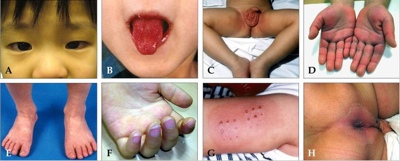
Kawasaki Disease
last authored: Amy Nason, MD 2010, Dalhousie University, June 2009
last reviewed:
Introduction
Also known as mucocutaneous lymph node disease, Kawasaki disease (KD)is a condition affecting children that causes inflammation, primarily of the arteries throughout the body, but also of the lymph nodes, skin and mucous membranes.

findings associated with KD, courtesy of Dong Soo Kim
It typically affects children between the ages of 2 and 5 years, with boys being affected more often than girls and those of Asian descent having slightly higher risk. It is very rare in infants younger than 3 months of age.
The Case of...
a simple case introducing clincial presentation and calling for a differential diagnosis to get students thinking.
Causes and Risk Factors
Also known as mucocutaneous lymph node disease, Kawasaki disease is a condition affecting children that causes inflammation, primarily of the arteries throughout the body, but also of the lymph nodes, skin and mucous membranes.
It typically affects children between the ages of 2 and 5 years, with boys being affected more often than girls and those of Asian descent having slightly higher risk. It is very rare in infants younger than 3 months of age.
Pathophysiology
Inflammation leads to necrosis of smooth muscle and ultimately the intima proliferates and thickens.
Signs, Symptoms, and Diagnosis
- phases of disease
- diagnostic criteria
Phases of Disease
Phase One
- fever
- red eyes (conjunctivitis)
- rash
- dry, cracked lips
- red, swollen tongue
- swollen, red hands and feet
- enlarged lymph nodes (usually in the neck)
Phase Two
- peeling of the skin on the hands and feet
- joint pain
- diarrhea and vomiting
- belly pain
Phase Three
- usually symptoms resolve during this time
Diagnostic Criteria
Clinical suspicion of Kawasaki disease is high when a child has a fever lasting at least 4 days and 4 or more of the following:
- lymphadenopathy > 1 cm
- polymorphous rash
- conjunctivitis (bilateral)
- mucous membrane changes (oral or pharyngeal mucosal injection, dry cracked lips, strawberry tongue)
- extremity changes (swollen or inflamed hands/feet, edematous hands or feet, membranous desqaumination of fingertips)
Investigations
- lab investigations
- diagnostic imaging
Lab Investigations
-
CBC: usually elevated white count, occasionally normocytic anemia and potentially thrombocytosis (rarely leading to thrombocytopenia)
-
Acute phase reactants: often elevated ESR and CRP
-
Liver enzymes: transaminases are elevated in approximately half of confirmed cases, a small percentage of children get an elevated bilirubin level
-
Urinalysis: pyuria and proteinuria may develop
-
Cardiac enzymes: elevated if infarction results as a consequence of inflammatory damage
Diagnostic Imaging
EKG: used to detect myocarditis or infarction
Differential Diagnosis
Other diseases that must be ruled out with a presentation suggestive of Kawasaki disease are:
- scarlet fever
- juvenile rheumatoid arthritis
- rocky mountain spotted fever
- stevens-johnson syndrome
- toxic shock syndrome
- measles
- CMV
- EBV
- mercury poisoning
Treatments
Typically these patients are managed by a rheumatologist. The main goals of treatment are to prevent coronary artery disease and relieve symptoms. The mainstays of treatment are:
-
intravenous gamma globulin (IVIG at 2g/kg)
-
anti-inflammatory medications (ie. Aspirin 80-100mg/kg/day in TID or QID divided doses during time of fever followed by 3-5 mg/kg/day OD once fever subsided)
Patients are kept in hospital until the fever subsides, after that the risk of developing significant heart disease is greatly lowered. They should be re-evaluated one week post-discharge and then have a repeat echocardiogram at one month. Generally treatment with aspirin is continued for up to six months but duration is greatly affected by clinical presentation and likelihood of long-term complications.
Consequences and Course
KD is the leading cause of acquired heart disease in children in North America. During the course of the illness about 20% (1 in 5) children will develop some form of heart problem but only a minority having lasting damage. The various heart problems are:
- myocarditis
- mitral regurgitation
- arrythmias
- vasculitis of the coronary arteries
- aneurysms (weaking of the coronary arteries secondary to inflammation)
- increased risk of clot formation (typically secondary to aneurysm)
- infarction
Resources and References
- Pemberton, Doughty, Middlehurst & Thornhill. 1999. Case Study: Recurrent Kawasaki Disease. British Dental Journal 186, 270 -271
- American Academy of Family Physicians
- Children’s Hospital Boston Kawasaki Disease Program
- American Heart Association
Topic Development
authors:
reviewers:
